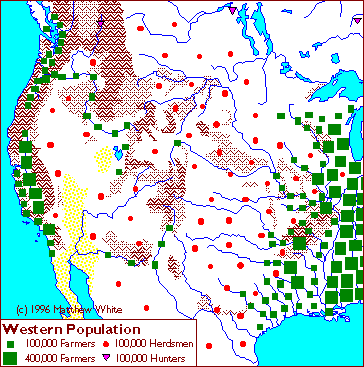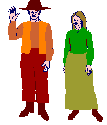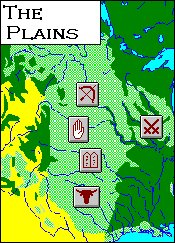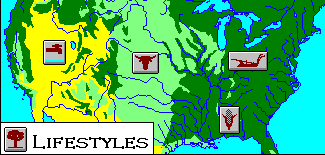Nomadic Herdsmen

Where water is too scarce to support agriculture, nomads drive herds of ruminents from pasture to pasture. On the grasslands of Great Plains, the nomadic lifestyle has reach a peak of affluence with vast herds of cattle and horses driven by wealthy, healthy tribes of brutal barbarians. In the scrubland of the western desert, however, the nomads are a more sorry bunch, riding burros and leading flocks of sheep and goats from waterhole to waterhole, arousing less envy and fear among their agricultural neighbors.
Food:
Humans cannot digest the grasses that cover the priarie, but they can eat the animals that eat the grasses - cattle, sheep and goats. Because it's more economical to drain an animal again and again rather than simply slaughtering it, the staples of the nomadic diet are dairy products such as milk, cheese, yogurt and butter; and blood tapped from non-vital arteries in small doses. In fact, the drinking of cattle blood is such an important part of the nomadic diet that it is one of the only Old Testament taboos not reimposed by the New Israelite religion. Meat is clearly secondary, although they do eat it almost daily, even in the dead of winter. It is usually roasted or barbicued over an open fire. They eat very few vegetables, except what they scrounge from the forests of the rivers and foothills.
 |
|||
Clothing:
The typical cowboy wears a light woolen workshirt, heavy leather boots -- pointy-toed and high-heeled to fit into a stirrup -- and leather pants to facilitate riding. He keeps the sun out of his eyes with a broad-brimmed hat of stiffened leather or felt. In colder weather, he will tuck a wool cap under his hat, and wrap himself in jackets and sweaters of wool and felt, quilted in flamboyant, abstract patterns (not shown). Woman dress similarly, except that they wear long skirts instead of pants.
Housing:
As they drive their herds from pasture to pasture, the nomads drag their villages along with them, and tribe of cowboys on the move always includes a long dusty caravan of covered wagons drawn by teams of oxen. Whenever the tribe settles in for more than an overnight stay, a city of teepees will sprout up for extra living space.

Fuel:
Because wood is in short supply on the open prairie, the principle fuel of the cowboys is dried cattle dung, which usually contains enough undigested grass to sustain a low flame for cooking. In the winter, when they need larger flames, they generally withdraw to the foothills or riverbanks, where they can chop timber.
Tools and Materials:
For the most part, the tools of the nomads are manufactured from the bodies of their animals: woven wool; pressed felt; rawhide straps and thongs; glue from boiled hooves; composite bows of bone and horn; sheepskin parchment. They make periodic forays into the mountains for the wood to build their wagons, and they trade with settled communities for the metal to make their knives.
 |


Last Updated April 1999
Copyright © 1999 Matthew White